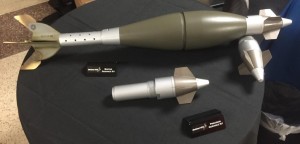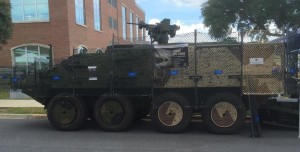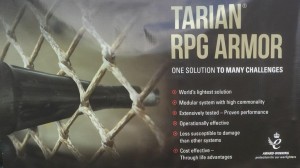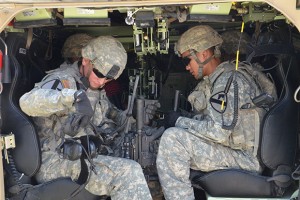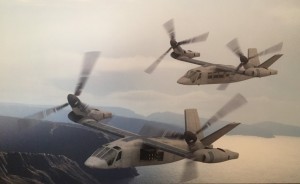 Front of Maneuver Center Headquarters during Maneuver Conference 2015. Photo by Will Rodriguez
Front of Maneuver Center Headquarters during Maneuver Conference 2015. Photo by Will Rodriguez I attended the Maneuver Conference 2015 at Ft. Benning this 14-17 September. As usual, it was a great event and if you are ever in Columbus Ga when the conference is being held it would be well worth your time to attend. I always leave informed impressed and foot weary from all there is to see.
Unlike many of the past conferences there weren’t as many new cutting edge developments. None-the-less, I walked away with several tidbits and insights enough for several future stand-alone articles I’ll need to write to do the subjects justice. What follows are several especially interesting things I saw at the conference that I wanted to share.
Not necessarily groundbreaking, I chatted with a prominent pistol manufacturer’s representative about the Modular Handgun System program. The program has been covered pretty well in the press including the very grandiose speculation that the Army will be adopting hollow point since “special munitions” are included in the requirements document. (Hollow point is not being adopted for general use by the military and has been in use by specific units for decades. More here.)
Besides the general talk that his company would be in compliance with all requirements what finally penetrated my brain is that this potential new pistol will have “ambidextrous” controls specifically an external safety, slide lock and magazine release. Ambidextrous in that while the specific potential future pistol will be friendly to left & right handed shooters it may not be able to be so simultaneously. At a minimum, shooters will be able to easily configure their pistol for left or right handed use. The Army has come a long way in catering to left handed soldiers.
The folks at Orbital ATK showed off their Precision Guidance Kit (PGK). The PGK is a fuze that can be screwed onto conventional “dumb” 155mm artillery projectiles and turn them into GPS precision munitions accurate inside 10 meters! The importance of this is given an accurate grid to a target one shell can take out a point target where it took a dozen to do so before. This allows an artillery unit’s basic load to go farther. This is an important leap.
Some technophiles will forget this development doesn’t really impact certain missions artillery is used for specifically smoke obscuration missions or final protective fires (FPF’s). FPF’s are the last ditch mission ground units request when they ae on the verge of being overrun and consist of erecting a wall of steel between oneself and an enemy that greatly outnumbers you. A fuze has also been developed for the 120mm mortar. The cost of this fuze is a tenth of the $100k missiles with the same capabilities.
The test bed Stryker from two year’s ago was on display without its 30mm remote weapon station/turret showing off Tarian’s anti—RPG armor and SAIC camouflage. Tarian’s anti-RPG solution is fascinating. It consists of a special net that damages or makes an RPG round explode prematurely defeating its HEAT capabilities. It weighs a fifth of what slat armor weighs (less than 500lbs vs well over a ton) and can be folded back against the vehicle for air transport. The latter is a huge advantage to deploying Stryker units early. The downside is the system costs about 30% more than the current system ($60k vs. $40k). Surprisingly the Army seems more interested in transporting and repairing old and heavy slat systems instead of investing in this solution.
The test bed vehicle was displayed with a dual machine-gun/Javelin missile Remote weapon system. The dual system is not fielded right now but would allow Strykers to fire the Javelin while soldiers are under armor. Another tidbit the General Dynamics representative shared was the Army has decided to up gun two Stryker Brigades in Europe in response to the Russian incursion in Crimea/Ukraine. The Army will field half of the Infantry carrier Strykers in Europe with a 30mm remote weapon system. While it might not look like the Konigsberg solution I covered last year, in two years’ time two Strykers of the four in each Stryker Infantry platoon in Europe will be fitted with a 30mm cannon. The gun will have light anti-armor as well as anti-personnel capabilities. Let’s pray the Russians can wait.
The Tank Automotive Research Development and Engineering Center (TARDEC) is researching extending the life of the Bradley. The thought is to eventually equip it with a remote weapon system and increase the four vehicles in a heavy mechanized Infantry platoon from four to six, each vehicle carrying a fire team. The plan also increases the technological sophistication of the vehicle by adding monitors for each soldier to observe what is happening outside the vehicle and a screen that displays the other vehicles positions. The intent is to facilitate squads linking up after dismounting from the vehicles.
The concept doesn’t address the immediate loss of technology upon leaving the vehicles. Nor does it address how is technology can overcome potential distances between squads which impact the dismounted squad’s ability to have mutually supporting fire teams. When I asked the role of the Bradleys were repeatedly put forth as supporting elements of the equation. That is true but it has more of a cavalry/vehicle centric approach to mechanized infantry than an Infantry centric approach. I’ll delve into this subject at a later time as it bears a very close resemblance to the Future Combat System (FCS) debate I was part of a little over a decade ago. I can only think of the saying, “those that forget history…”
The final high point of the conference was developments with Bell’s V280 Valor tilt rotor concept. It would replace the Blackhawk and possibly the Apache gunship. Doing the subject justice requires its own essay (coming) but interesting highlights include increased technological capability for the Infantry squad in flight, interest from the Marine Corps as a replacement to the UH1Y and the actually building of a flying prototype.
Above are just the high points from an equipment/doctrine perspective of the conference. I met dozens of soldiers that shared their perspectives on a variety of things the Army is doing and whom I will be interviewing in the future to share some of the great things happening in the Army today. The Conference was as always, an awesome experience that I can’t recommend strongly enough. I hope you were as fascinated and informed by some of what I saw as I was.

